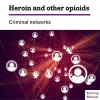European Police Office (Europol)
Europol–EMCDDA cooperation
Cooperation between the EMCDDA and Europol started in 1997 after the launch of the 1997 EU Joint action concerning the information exchange, risk assessment and control of new synthetic drugs. Europol is a key EMCDDA partner within the European Union Early Warning System on new psychoactive substances (EU EWS) and involvement in organised crime criteria is an integral part of the scientific risk assessment of new substances. Currently, under the terms of the 2005 Council Decision on the information exchange, risk assessment and control of new psychoactive substances, the EMCDDA and Europol, in collaboration with their respective networks, play a central role in detecting new psychoactive drugs and assessing their characteristics. This process may lead to recommendations to bring new substances under control measures in all the Member States of the European Union.
Collaboration has been also developed in areas set out in the EU Drugs Action Plan 2013–16 aimed at scaling up the monitoring of illicit drug supply in Europe through developing key indicators in three domains: drug markets, drug-related crime and drug supply reduction. Work with Europol has focussed on the development of systematic data collection on synthetic drug production sites, cannabis production sites and secondary cocaine extraction laboratories, where cocaine is chemically removed from carrier materials such as plastics.
In parallel to this, the EMCDDA closely collaborates with Europol on the implementation of the Operational Action Plans (OAPs) developed under the EU policy cycle for organised and serious international crime 2014–17 within the Council’s Standing Committee on Operational Cooperation on Internal Security (COSI). The EMCDDA is active in the synthetic drugs, cocaine and heroin priority areas.
The two agencies also work together to provide threat assessments and strategic analysis of drug markets, which has been achieved through joint EMCDDA-Europol publications. Such reports have included in-depth studies on methamphetamine, cocaine and amphetamine. Intensive collaboration between the agencies also resulted in the EU drug markets report: a strategic analysis in 2013, the EU Drug markets report: In-depth analysis in 2016 and the report Drugs and the darknet in 2017. These reports provide an overview of drug production, trafficking and consumption in Europe, combining the EMCDDA’s structured data sets with the latest trends and intelligence on organised crime from Europol.
News
Events
Publications
Document library
Media library
Contact information
Europol
The Hague
The Netherlands
















